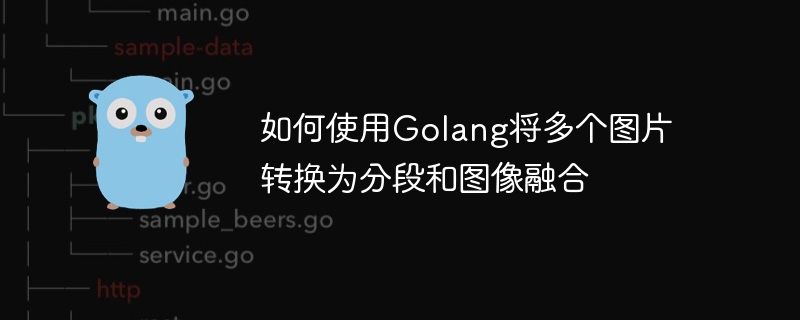
如何使用Golang将多个图片转换为分段和图像融合
概述:
在本文中,我们将使用Golang编程语言展示如何将多个图片转换为分段和图像融合。我们将使用Golang的图像处理库和简单的算法来实现这个过程。通过将多个图片转换为图像的不同部分,然后将它们融合在一起,我们可以创建出一个新的有趣和独特的图像。
步骤1: 导入所需的库
首先,我们需要导入Golang的图像处理库以及其他所需的库。在我们的代码中,我们将使用image和os库。
package main
import (
"fmt"
"image"
_ "image/jpeg"
"image/png"
"os"
)步骤2: 加载多个图片
接下来,我们需要加载多个图片。我们可以使用Golang的image.Decode函数来加载图片文件。
func loadImage(path string) (image.Image, error) {
file, err := os.Open(path)
if err != nil {
return nil, err
}
defer file.Close()
img, _, err := image.Decode(file)
if err != nil {
return nil, err
}
return img, nil
}
func loadImages(paths []string) ([]image.Image, error) {
var images []image.Image
for _, path := range paths {
img, err := loadImage(path)
if err != nil {
return nil, err
}
images = append(images, img)
}
return images, nil
}步骤3: 分割图片
接下来,我们将实现一个函数来将图片分割成多个部分。我们可以使用Golang的image库来获取图片的宽度和高度,并根据需要分割成相等大小的部分。
func splitImage(img image.Image, rows, cols int) [][]image.Image {
bounds := img.Bounds()
width := bounds.Max.X - bounds.Min.X
height := bounds.Max.Y - bounds.Min.Y
cellWidth := width / cols
cellHeight := height / rows
var splitImages [][]image.Image
for row := 0; row < rows; row++ {
var rowImages []image.Image
for col := 0; col < cols; col++ {
x := bounds.Min.X + col*cellWidth
y := bounds.Min.Y + row*cellHeight
r := image.Rect(x, y, x+cellWidth, y+cellHeight)
subImage := imaging.Crop(img, r)
rowImages = append(rowImages, subImage)
}
splitImages = append(splitImages, rowImages)
}
return splitImages
}步骤4: 图像融合
最后,我们将实现一个函数来将分割后的图片融合在一起。在这个例子中,我们将使用简单的算法,将每个时刻的像素值累加起来,并对结果取平均值。
func mergeImages(images [][]image.Image) image.Image {
rows := len(images)
cols := len(images[0])
cellWidth := images[0][0].Bounds().Dx()
cellHeight := images[0][0].Bounds().Dy()
merged := image.NewRGBA(image.Rect(0, 0, cellWidth*cols, cellHeight*rows))
for row := 0; row < rows; row++ {
for col := 0; col < cols; col++ {
x := col * cellWidth
y := row * cellHeight
subImage := images[row][col]
rect := image.Rect(x, y, x+cellWidth, y+cellHeight)
draw.Draw(merged, rect, subImage, image.Point{}, draw.Over)
}
}
return merged
}步骤5: 完整代码示例
下面是一个完整的代码示例,演示了如何将多个图片转换为分段和图像融合。
package main
import (
"fmt"
"image"
_ "image/jpeg"
"image/png"
"os"
)
func loadImage(path string) (image.Image, error) {
file, err := os.Open(path)
if err != nil {
return nil, err
}
defer file.Close()
img, _, err := image.Decode(file)
if err != nil {
return nil, err
}
return img, nil
}
func loadImages(paths []string) ([]image.Image, error) {
var images []image.Image
for _, path := range paths {
img, err := loadImage(path)
if err != nil {
return nil, err
}
images = append(images, img)
}
return images, nil
}
func splitImage(img image.Image, rows, cols int) [][]image.Image {
bounds := img.Bounds()
width := bounds.Max.X - bounds.Min.X
height := bounds.Max.Y - bounds.Min.Y
cellWidth := width / cols
cellHeight := height / rows
var splitImages [][]image.Image
for row := 0; row < rows; row++ {
var rowImages []image.Image
for col := 0; col < cols; col++ {
x := bounds.Min.X + col*cellWidth
y := bounds.Min.Y + row*cellHeight
r := image.Rect(x, y, x+cellWidth, y+cellHeight)
subImage := imaging.Crop(img, r)
rowImages = append(rowImages, subImage)
}
splitImages = append(splitImages, rowImages)
}
return splitImages
}
func mergeImages(images [][]image.Image) image.Image {
rows := len(images)
cols := len(images[0])
cellWidth := images[0][0].Bounds().Dx()
cellHeight := images[0][0].Bounds().Dy()
merged := image.NewRGBA(image.Rect(0, 0, cellWidth*cols, cellHeight*rows))
for row := 0; row < rows; row++ {
for col := 0; col < cols; col++ {
x := col * cellWidth
y := row * cellHeight
subImage := images[row][col]
rect := image.Rect(x, y, x+cellWidth, y+cellHeight)
draw.Draw(merged, rect, subImage, image.Point{}, draw.Over)
}
}
return merged
}
func main() {
paths := []string{"image1.jpg", "image2.jpg", "image3.jpg"}
images, err := loadImages(paths)
if err != nil {
fmt.Println("Failed to load images:", err)
return
}
rows := 2
cols := 2
splitImages := splitImage(images[0], rows, cols)
merged := mergeImages(splitImages)
output, err := os.Create("output.png")
if err != nil {
fmt.Println("Failed to create output file:", err)
return
}
defer output.Close()
err = png.Encode(output, merged)
if err != nil {
fmt.Println("Failed to encode output file:", err)
return
}
fmt.Println("Image conversion and merging is done!")
}总结:
以上是使用Golang将多个图片转换为分段和图像融合的步骤和代码示例。通过使用Golang的图像处理库和简单的算法,我们可以轻松实现这个过程。你可以根据需要调整分割和融合的参数,创建出不同形式和风格的图像。希望这篇文章对你有所帮助!



